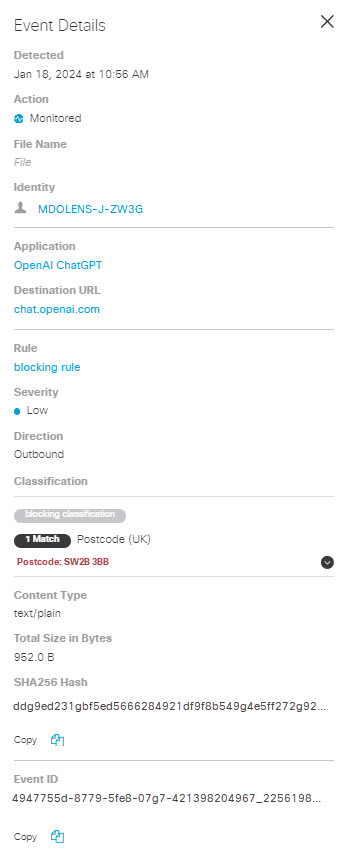View Details
- Click the action menu icon (three dots) for any event to view a menu of options. Click
View details.

- The Event Details window displays some of the same content as the report table, with additional information which varies depending upon the Event Type:
Real Time Events
Detected—The date and time the content was detected.
Action—The action triggered by the rule on detecting a violation.
File Name—The name of the file where a classification match was found. When content is found in a message or a post, the File name displays Content.
Identity—The identity that made the request.
Private Resource —The private resource where the file was uploaded or posted.
Private Resource Group — The private resource group where the file was uploaded or posted.
Destination URL— For private resources or private resource groups, the URL where the file was uploaded or posted.
Destination Port— For private resources or private resource groups, the port where the file was uploaded or posted.
Destination Protocol— For private resources or private resource groups, the protocol used to upload or post the file.
Destination IP— For private resources or private resource groups, the IP address where the file was uploaded to posted.
Application—The application where the file was uploaded or posted.
Application Category—The category for the application where the file was uploaded or posted.
Destination URL—The URL of the destination for the event.
Rule—The rule that triggered the event.
Severity—The severity of the rule that triggered the event.
File Label—File label names in the value of the file's document properties. This includes Microsoft Office Document Properties, Microsoft Office Sensitivity Labels, and AdobePDF Document Properties.
Direction—Direction of traffic.
Classification—The classification that matched the content found in the event. Clicking the caret will display the excerpts where the matches were found.
Content Type—The type of data that triggered the event.
Total Size in Bytes—The size of the file that triggered the event.
SHA256 Hash—The unique SHA256 hash for the file. (You may copy this using the Copy icon.)
Event ID—A unique identifier for the event. (You may copy this using the Copy icon.)

SaaS API Events
A timeline of events associated with the file.
Application—The application where the file was uploaded or posted.
Tenant—The Secure Access tenant associated with the event.
Resource ID— The URL for the resource associated with the content that triggered the violation. For Azure S3 the resource is an S3 bucket. For Azure Storage the resource is a storage account or container. For other applications, this does not apply.
Resource Name—For AWS S3 this displays the S3 bucket associated with the content that triggered the violation. For Azure Storage this displays the storage account or container associated with the content that triggered the violation. For other applications, this does not apply.
Destination URL—The URL of the destination for the event. (Note: For some platforms, a single file or message can trigger multiple events that show the same Destination URL for each event.)
File/Message Direction—The direction of the message or file that triggered the event: Incoming or Outgoing. Note: For Outlook, this will always be Outgoing.
Rule—The rule that triggered the event.
Severity—The severity of the rule that triggered the event.
Exposure—An indication of who can see the file—internal or external users.
Classification—The classification that matched the content found in the event. Clicking the caret will display the excerpts where the matches were found.
Content Type—The type of data that triggered the event.
Total Size in Bytes—The size of the file that triggered the event.
SHA256 Hash—The unique SHA256 hash for the file.
Unique Event ID—A unique identifier for the event.

AI Guardrails Events
Detected—The date and time the content was detected.
Action—The action triggered by the rule on detecting a violation.
File Name—If the classification match is found in a prompt or response, this item displays Form. If the classification match appears within an embedded file, the file name appears here.
Identity—The identity that made the request.
Application—The application where the file was uploaded or posted.
Application Category—The category for the application where the file was uploaded or posted.
Destination URL—The URL of the destination for the event.
Rule—The rule that triggered the event.
Severity—The severity of the rule that triggered the event.
Direction—Direction of traffic.
Classification—The AI guardrails data classification that matched the content found in the event. Clicking the caret displays the excerpts where the matches were found.
Content Type—The type of data that triggered the event.
Total Size in Bytes—The size of the file that triggered the event.
SHA256 Hash—The unique SHA256 hash for the file. (You may copy this using the Copy icon.)
Event ID—A unique identifier for the event. (You may copy this using the Copy icon.)


